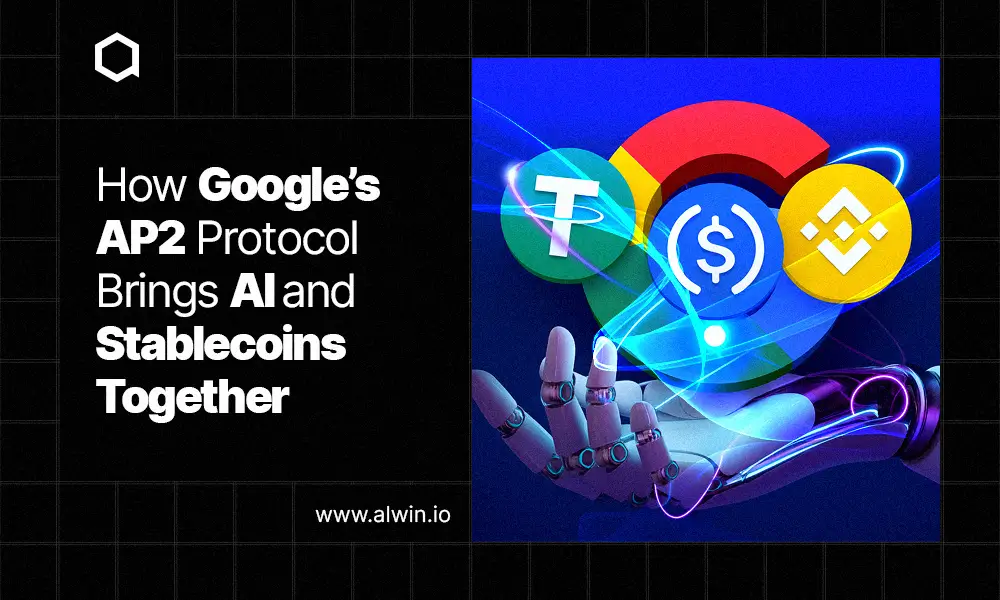Artificial intelligence has rapidly shifted from answering queries to performing real-world actions. By 2025, AI agents are no longer just assistants that generate text or images—they’re autonomous actors capable of booking tickets, managing shopping lists, making investment recommendations, and even negotiating contracts.
But there’s a bottleneck
For an AI agent to truly function independently, it must be able to pay securely, reliably, and legally. Traditional payment systems are built around human presence and approval. What happens when the “buyer” is an autonomous program, not a person?
That’s the challenge Google is tackling with its newly introduced Agent Payments Protocol (AP2). It’s an open, payment-agnostic framework designed to handle transactions in the era of agentic AI. And with its x402 extension, AP2 goes beyond traditional rails to support crypto and stablecoin-based payments—unlocking instant, verifiable, and programmable transactions.
What Is AP2?
AP2, or Agent Payments Protocol, is a new industry standard for AI-driven payments. It provides a trusted “language” for communication between:
Users → People giving the instructions.
Agents → AI systems acting on behalf of users.
Merchants → Businesses selling products or services.
Payment Providers → Banks, card networks, or crypto stablecoin systems.
Unlike existing methods, AP2 is built to handle delegated payments, where the user isn’t present at the moment of purchase.
Key Features of AP2
✅ Payment-Agnostic – Works with both traditional finance (cards, banks) and digital assets (stablecoins, crypto).
✅ Mandate-Based Authorization – Purchases are governed by cryptographic mandates tied to user intent.
✅ Auditability & Accountability – Every step is traceable, ensuring transparency if disputes arise.
✅ Extensible Architecture – With the x402 extension, AP2 can natively handle blockchain-based payments.
The Problem AP2 Solves: AI Agents + Payments
1. Human-Present Mode
In this scenario, the AI assists but does not act alone.
Example: You ask your AI assistant to find you the cheapest flight to New York.
It shows you options, you review them, and then you approve the purchase.
The payment happens while you are watching, and your intent is directly confirmed in real-time.
In this mode, traditional payment systems work fine, because they only need a confirmation at the moment of purchase.
2. Delegated Mode
This is where the challenge emerges.
Example: You tell your AI agent:
“Buy two concert tickets if they go on sale for under $200 each.”
The AI monitors ticket websites in the background.
At 3 AM, while you are asleep, it finds two tickets at $180 each and executes the payment automatically.
In this case, the user isn’t present at the moment of purchase.
Traditional systems struggle here because:
There’s no human confirmation step.
Merchants can’t verify whether the AI had proper authority.
The user risks being charged for things they didn’t explicitly approve at that moment.
Why is it risky without AP2?
An AI could misinterpret instructions (buy the wrong concert or wrong date).
A malicious agent could overspend or make unauthorized purchases.
Merchants may reject unattended transactions because they can’t validate intent.
AP2 is designed to bridge this gap by introducing mandates that bind user intent to agent actions in a verifiable way.
Key Challenges in AI-Driven Payments
When AI takes over the responsibility of paying, three fundamental challenges arise:
Authorization
When AI agents start making payments, the first big challenge is authorization—how to prove that a purchase was truly approved by the user. In traditional systems, this is simple: a user swipes a card, enters a PIN, or taps “confirm.” But with delegated AI payments, the user might not be present at all, making it difficult to verify intent. For example, if you instruct your agent to “buy groceries under $50,” but it ends up spending $200, there’s no straightforward way to prove whether the agent misbehaved or simply misunderstood. This is where AP2 steps in. The protocol introduces Intent Mandates, which are cryptographically signed instructions created by the user. These mandates clearly define boundaries such as spending limits, categories, or timing. Before any payment is executed, the agent’s action must be checked against the mandate, so that every purchase is both authorized and within the constraints set by the user.
Authenticity
Authenticity in AI-driven payments revolves around whether a purchase truly reflects the user’s intent. Since AI agents can misinterpret instructions or “hallucinate,” merchants risk fulfilling requests that may not align with what the user actually wanted. For example, asking for “Nike shoes under $100” could mistakenly result in the purchase of “Nike accessories.” To solve this, AP2 introduces Cart Mandates, which lock in the exact items, prices, and quantities, cryptographically tying them back to the original user intent. This ensures merchants can verify that purchases directly match user instructions.
Accountability
Alongside authenticity comes the challenge of accountability. In today’s systems, the human cardholder bears responsibility for all transactions, but AI complicates this model. Errors could arise from unclear instructions, agent misbehavior, merchant mishandling, or even the bank authorizing a suspicious transaction. Determining who is at fault requires new frameworks that fairly distribute accountability among users, agents, merchants, and financial institutions.
How AP2 Works: Mandates, Verifiable Credentials & Flow?
The core idea of AP2 is to establish a chain of verifiable consent and intent, linking what the user wanted to what the agent executed, in a tamper-evident way. Here’s how:
Intent Mandate
When you instruct an agent to perform something (e.g. “Monitor price, buy if below $200”), the protocol captures that in an Intent Mandate: a cryptographically signed statement of your instruction and constraints (timing, price bounds, conditions).
This mandate becomes part of the “audit trail” that binds your intent to later transactions.
Cart Mandate
Once the agent finds a candidate item (or a set of items), before proceeding to payment, it presents a “cart” (the exact item(s), prices, quantities). At this point, the user (if present) signs or approves a Cart Mandate. That mandate locks in the exact item(s) and price(s).
Even in delegated mode, the agent must make sure its Cart Mandate remains within the constraints of the original Intent Mandate.
Linking to Payment Method
Once the Cart Mandate is in place, the payment method is cryptographically tied to it. The payment (whether card, bank transfer, or stablecoin) is executed in a way that can be verified against the mandate. This make sure what you see is what you pay for - no silent changes.
Because mandates are signed and verifiable, the entire transaction (intent → cart → payment) is auditable and non-repudiable.
Supporting All Payment Methods (Fiat & Stablecoins)
AP2 is payment-agnostic, supporting cards, bank transfers, real-time payments, and digital assets. This flexibility allows AI agents to work across both traditional finance and Web3.
x402 Extension (Crypto & Stablecoins)
Enables agent-to-agent payments using stablecoins (e.g., USDC).
Makes micropayments (data, compute, API fees) practical.
Uses blockchain receipts as verifiable proof of payment.
Integrates with Ethereum/Web3 for interoperability and composability.
Together, AP2 + x402 bridges fiat and crypto payments trust, auditability, and stable AI-driven transactions.
How AI and Stablecoins Interact Through AP2?
With AP2 and x402, AI agents can now carry out economic actions using stablecoins and that opens many possibilities.
Micropayments and Agent-to-Agent Settlements
Imagine an AI agent needs to fetch some data from another agent (e.g. a specialized search or translation). That “provider” agent can charge a few cents (or micro-amounts) in stablecoins, and the requestor agent pays directly, all automatically via AP2/x402 protocols.
This allows to an agentic economy of microservices, where services are discovered and paid for in real time. No invoicing, no human effort.
Faster Finality, Lower Friction
Stablecoins on appropriate chains can settle much faster and with lower transaction costs compared to legacy rails. When agents need to act quickly, waiting for ACH or card settlement is too slow. Stablecoins give them a better option, especially for rapid or tiny payments
Use Cases: Data, Compute, Services
A web scraping agent pays another agent per page crawl.
A translation agent is compensated to convert text.
An analytics or AI model agent pays compute providers for extra GPU time.
A shopping agent can pay for inventory checks or price APIs through crypto rails.
In all cases, stablecoin + AP2, the payment remains formally linked to what the user intended.
Risks, Challenges & Open Issues
Security & Fraud - Compromised agents could trigger malicious transactions. Protecting mandates, credentials, and identities is essential.
Liability & Accountability - Who pays for errors or fraud user, developer, merchant, or bank? AP2 helps, but legal clarity is lacking.
Regulation & Compliance - Stablecoins face AML, KYC, tax, and cross-border scrutiny. AP2 + crypto must align with global regulations.
Standards & Interoperability - Success depends on open standards, industry adoption, and bridging with legacy systems.
Adoption Barriers - Merchants, banks, and processors must invest and trust autonomous agent payments adoption may be slow.
Future Outlook: What Comes Next?
Standardization & Open Source Growth
Google has already opened AP2’s technical specifications and reference code on GitHub, inviting community contributions and evolution. Expect standard bodies or consortia to adopt or endorse AP2 over time.
Rise of Agentic Economy
With payments enabled, AI agents may increasingly handle many everyday tasks: shopping, subscriptions, procurement, scheduling, and more. As the “agentic economy” rises, stablecoins may become the lingua franca for agent payments.
Integration with DeFi & Web3
Agents might directly interact with DeFi protocols: borrowing, staking, swapping, bridging funds, or arbitrage, all powered by stablecoin rails and AP2 for governance and trust.
New Business Models
Pay-per-use AI services
Agent marketplaces where agents compete and pay each other
Autonomous subscription renewals, dynamic purchasing
Smart “agent wallets” holding stablecoin balance, with built-in mandates
End up
Google’s AP2 aims to make AI agents transact securely and autonomously, bridging traditional finance and Web3 through mandates, verifiable credentials, and stablecoin support via x402.
If successful, it could transform commerce with agent-driven purchases and microtransactions. But security, legal, and adoption challenges will decide whether AP2 becomes a global standard or just an ambitious experiment.


